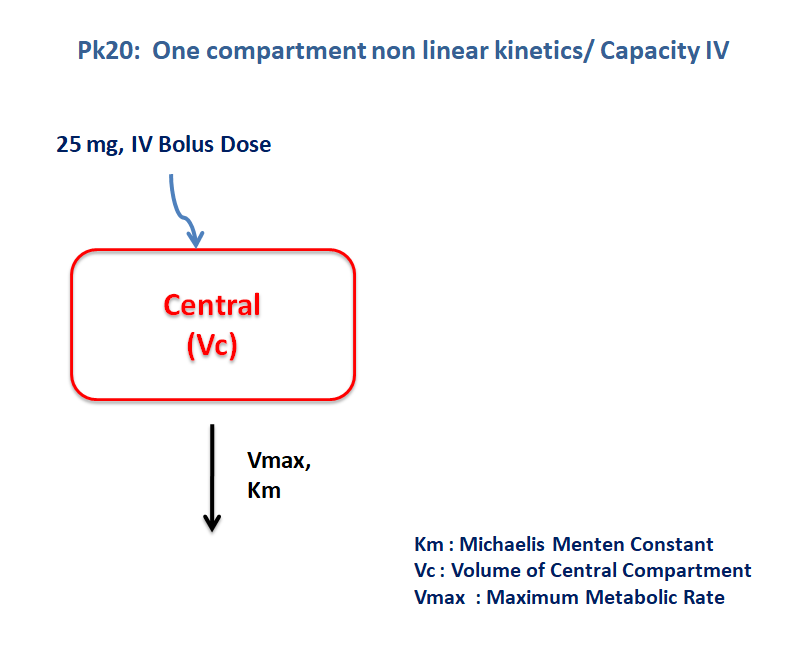using PumasUtilities
using Random
using Pumas
using CairoMakie
using AlgebraOfGraphics
using CSV
using DataFramesMeta
using Dates
PK20 - One-compartment model with capacity limited elimination for IV bolus
1 Background
- Structural Model - One Compartment Model with nonlinear elimination.
- Route of administration - IV bolus
- Dosage Regimen - 25 mg and 100 mg
- Number of Subjects - 2

2 Learning Outcome
This exercise demonstrates simulating IV bolus with different dosage regimens and different Vmax and Km values with capacity limited elimination from a one compartment model.
3 Objectives
To build a one-compartment model for an IV bolus dose with capacity limited elimination, simulate the model for each subject, and subsequently perform a simulation for a population.
4 Libraries
Load the necessary libraries.
5 Model definition
Note the expression of the model parameters with helpful comments. The model is expressed with differential equations. Residual variability is a proportional error model.
pk_20 = @model begin
@metadata begin
desc = "One Compartment Model - Nonlinear Elimination"
timeu = u"hr"
end
@param begin
"""
Volume of Central Compartment (L)
"""
tvvc ∈ RealDomain(lower = 0)
"""
Michaelis menten Constant (μg/L)
"""
tvkm ∈ RealDomain(lower = 0)
"""
Maximum Rate of Metabolism (μg/hr)
"""
tvvmax ∈ RealDomain(lower = 0)
Ω ∈ PDiagDomain(3)
"""
Proportional RUV
"""
σ_prop ∈ RealDomain(lower = 0)
end
@random begin
η ~ MvNormal(Ω)
end
@pre begin
Vc = tvvc * exp(η[1])
Km = tvkm * exp(η[2])
Vmax = tvvmax * exp(η[3])
end
@dynamics begin
Central' = -(Vmax * (Central / Vc) / (Km + (Central / Vc)))
end
@derived begin
cp = @. Central / Vc
"""
Observed Concentration (μg/L)
"""
dv ~ @. Normal(cp, cp * σ_prop)
end
endPumasModel
Parameters: tvvc, tvkm, tvvmax, Ω, σ_prop
Random effects: η
Covariates:
Dynamical system variables: Central
Dynamical system type: Nonlinear ODE
Derived: cp, dv
Observed: cp, dv6 Initial Estimates of Model Parameters
The model parameters for simulation are the following. Note that tv represents the typical value for parameters.
Km- Michaelis menten Constant (μg/L)Vc- Volume of Central Compartment (L),Vmax- Maximum rate of metabolism (μg/hr),Ω- Between Subject Variability,σ- Residual error
A vector of model parameter values is defined.
param1are the parameter values for Subject 1param2are the parameter values for Subject 2
param1 = (
tvkm = 261.736,
tvvmax = 36175.1,
tvvc = 48.9892,
Ω = Diagonal([0.01, 0.01, 0.01]),
σ_prop = 0.01,
)param2 = (param1..., tvkm = 751.33)Merge both parameters
param = vcat(param1, param2)7 Define the Dosage Regimen and Subjects
- Subject 1 - receives an IV dose of 25 mg or 25000 μg
- Subject 2 - receives an IV dose of 100 mg or 100000 μg
ev1 = DosageRegimen(25000, time = 0, cmt = 1)| Row | time | cmt | amt | evid | ii | addl | rate | duration | ss | route |
|---|---|---|---|---|---|---|---|---|---|---|
| Float64 | Int64 | Float64 | Int8 | Float64 | Int64 | Float64 | Float64 | Int8 | NCA.Route | |
| 1 | 0.0 | 1 | 25000.0 | 1 | 0.0 | 0 | 0.0 | 0.0 | 0 | NullRoute |
sub1 = Subject(id = 1, events = ev1, time = 0.01:0.01:2)Subject
ID: 1
Events: 1ev2 = DosageRegimen(100000, time = 0, cmt = 1)| Row | time | cmt | amt | evid | ii | addl | rate | duration | ss | route |
|---|---|---|---|---|---|---|---|---|---|---|
| Float64 | Int64 | Float64 | Int8 | Float64 | Int64 | Float64 | Float64 | Int8 | NCA.Route | |
| 1 | 0.0 | 1 | 100000.0 | 1 | 0.0 | 0 | 0.0 | 0.0 | 0 | NullRoute |
sub2 = Subject(id = 2, events = ev2, time = 0.01:0.01:8)Subject
ID: 2
Events: 1pop = [sub1, sub2]Population
Subjects: 2
Observations: 8 Single-Subject Simulation
Simulate the plasma drug concentration for the two subjects
Initialize the random number generator with a seed for reproducibility of the simulation.
Random.seed!(123)sim = map(((subject, paramᵢ),) -> simobs(pk_20, subject, paramᵢ), zip(pop, param))Simulated population (Vector{<:Subject})
Simulated subjects: 2
Simulated variables: cp, dv9 Visualize Results
@chain DataFrame(sim) begin
dropmissing(:cp)
data(_) *
mapping(
:time => "Time (hours)",
:cp => "Concentration (μg/L)";
color = :id => "Subject",
) *
visual(Lines; linewidth = 4)
draw(;
figure = (; fontsize = 22),
axis = (; xticks = 0:1:8),
legend = (; position = :bottom),
)
end10 Population Simulation
We perform a population simulation with 45 participants.
This code demonstrates how to write the simulated concentrations to a comma separated file (.csv).
par1 = (
tvkm = 261.736,
tvvmax = 36175.1,
tvvc = 48.9892,
Ω = Diagonal([0.09, 0.04, 0.0225]),
σ_prop = 0.0927233,
)
par2 = (
tvkm = 751.33,
tvvmax = 36175.1,
tvvc = 48.9892,
Ω = Diagonal([0.04, 0.09, 0.0225]),
σ_prop = 0.0628022,
)
## Subject 1
ev1 = DosageRegimen(25000, time = 0, cmt = 1)
pop1 = map(i -> Subject(id = i, events = ev1), 1:45)
Random.seed!(1234)
sim_pop1 = simobs(pk_20, pop1, par1, obstimes = [0.08, 0.25, 0.5, 0.75, 1, 1.5, 2])
sim_plot(sim_pop1, yaxis = :log)
df1_pop = DataFrame(sim_pop1)
## Subject 2
ev2 = DosageRegimen(100000, time = 0, cmt = 1)
pop2 = map(i -> Subject(id = 1, events = ev2), 1:45)
Random.seed!(1234)
sim_pop2 = simobs(pk_20, pop2, par2, obstimes = [0.08, 0.25, 0.5, 0.75, 1, 1.5, 2, 4, 6, 8])
sim_plot(sim_pop2, yaxis = :log)
df2_pop = DataFrame(sim_pop2)
pkdata_20_sim = vcat(df1_pop, df2_pop)
#CSV.write("pk_20_sim.csv", pkdata_20_sim)11 Conclusion
This tutorial showed how to build a one compartment model for an IV bolus dose with capacity limited elimination and perform a single subject and population simulation.